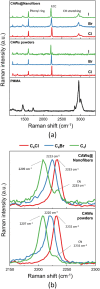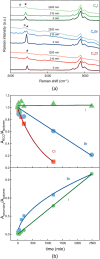Probing the Stability of Halogenated Carbon Atomic Wires in Electrospun Nanofibers via Raman Spectroscopy
- PMID: 40697402
- PMCID: PMC12278307
- DOI: 10.1021/acs.jpcc.5c02960
Probing the Stability of Halogenated Carbon Atomic Wires in Electrospun Nanofibers via Raman Spectroscopy
Abstract
Carbon atomic wires (CAWs) are one-dimensional (1D) sp-carbon nanostructures with remarkable electronic, mechanical, and optical properties, but their instability limits their practical applications. Embedding them in solid matrices can enhance their stability. This work reports the first example of electrospun nanofibers embedding halogenated CAWs. A solution of poly-(methyl methacrylate) and CAWs in N,N-dimethylformamide was electrospun using various parameters to investigate the effects on fiber morphology and diameter. Halogenated CAWs were successfully incorporated with a minimal morphological impact. Raman spectroscopy confirmed effective embedding and CAWs stability during electrospinning. The halogenated CAWs showed resistance to degradation for at least six months and demonstrated enhanced thermal stability when embedded within nanofibers. Additionally, our work investigated the influence of different halogen terminations on the degradation kinetics of CAWs upon exposure to these conditions. Similarly, photodegradation studies revealed improved photostability within fibers and demonstrated how CAWs chemical structure affects degradation pathways, including possible homolytic C-X bond cleavage. This work introduces electrospun nanofibers as a novel platform for stabilizing CAWs, offering advantages over thin films, such as better homogeneity, larger surface area, and comparable stability. These findings open new perspectives for CAWs-based nanocomposites in electronics, electrochemistry, and energy-related applications.
© 2025 The Authors. Published by American Chemical Society.
Figures






Similar articles
-
Sexual Harassment and Prevention Training.2024 Mar 29. In: StatPearls [Internet]. Treasure Island (FL): StatPearls Publishing; 2025 Jan–. 2024 Mar 29. In: StatPearls [Internet]. Treasure Island (FL): StatPearls Publishing; 2025 Jan–. PMID: 36508513 Free Books & Documents.
-
How lived experiences of illness trajectories, burdens of treatment, and social inequalities shape service user and caregiver participation in health and social care: a theory-informed qualitative evidence synthesis.Health Soc Care Deliv Res. 2025 Jun;13(24):1-120. doi: 10.3310/HGTQ8159. Health Soc Care Deliv Res. 2025. PMID: 40548558
-
Falls prevention interventions for community-dwelling older adults: systematic review and meta-analysis of benefits, harms, and patient values and preferences.Syst Rev. 2024 Nov 26;13(1):289. doi: 10.1186/s13643-024-02681-3. Syst Rev. 2024. PMID: 39593159 Free PMC article.
-
Management of urinary stones by experts in stone disease (ESD 2025).Arch Ital Urol Androl. 2025 Jun 30;97(2):14085. doi: 10.4081/aiua.2025.14085. Epub 2025 Jun 30. Arch Ital Urol Androl. 2025. PMID: 40583613 Review.
-
Short-Term Memory Impairment.2024 Jun 8. In: StatPearls [Internet]. Treasure Island (FL): StatPearls Publishing; 2025 Jan–. 2024 Jun 8. In: StatPearls [Internet]. Treasure Island (FL): StatPearls Publishing; 2025 Jan–. PMID: 31424720 Free Books & Documents.
References
-
- Casari C. S., Milani A.. Carbyne: From the elusive allotrope to stable carbon atom wires. MRS Commun. 2018;8:207–219. doi: 10.1557/mrc.2018.48. - DOI
-
- Cataldo F., Ursini O., Milani A., Casari C. S.. One-pot synthesis and characterization of polyynes end-capped by biphenyl groups (α,ω-biphenylpolyynes) Carbon. 2018;126:232–240. doi: 10.1016/j.carbon.2017.09.098. - DOI
-
- Gulia N., Pigulski B., Szafert S.. Palladium End-Capped Polyynes via Oxidative Addition of 1-Haloalkynes to Pd(PPh3)4 . Organometallics. 2015;34:673–682. doi: 10.1021/om501105w. - DOI
-
- Cataldo F.. Polyynes: A new class of carbon allotropes. About the formation of dicyanopolyynes from an electric arc between graphite electrodes in liquid nitrogen. Polyhedron. 2004;23:1889–1896. doi: 10.1016/j.poly.2004.04.024. - DOI
LinkOut - more resources
Full Text Sources
